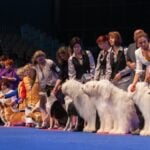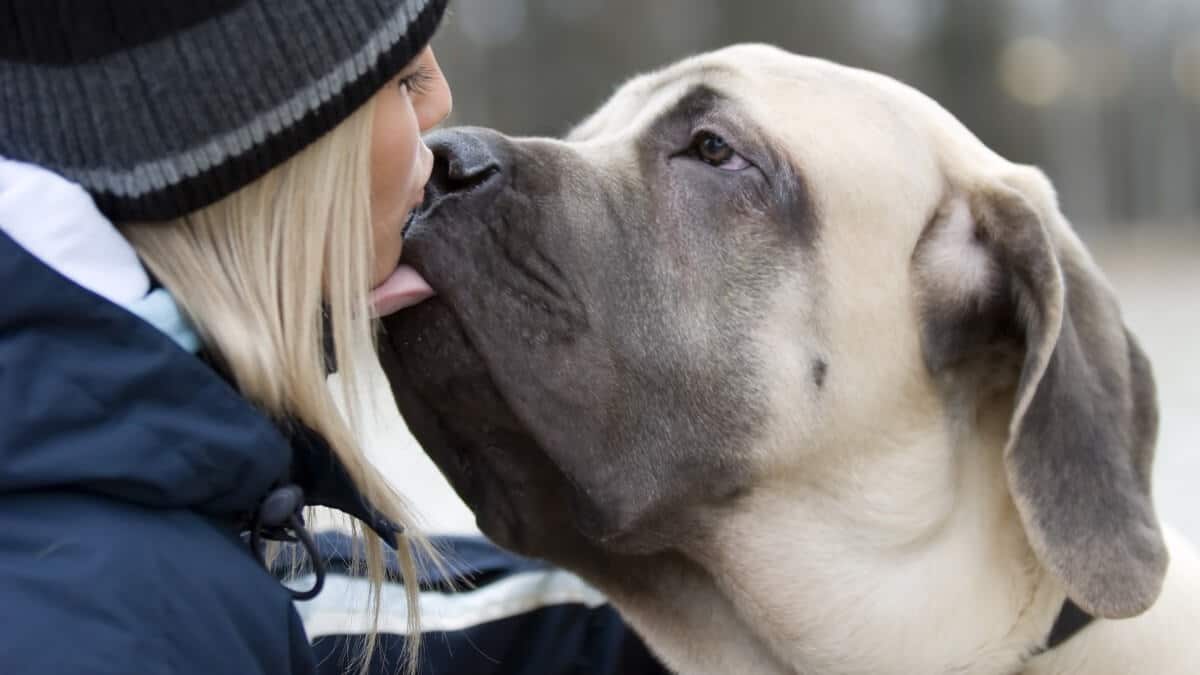
Home » The Hair of the Dog…

The “hair of the dog” is a common expression for those who drink to excess, wake up with a biting hangover, and decide that a Bloody Mary for breakfast sounds like a good idea. In Mastiffs, while alcohol is generally not involved, the hair of the dog has its own particular bite.
Long hair in the Mastiff breed has become a very controversial topic recently, as has the amount of white hair in the breed. Understanding these issues requires a little knowledge of breed history. There are two topics that must be considered: the origin of coat and color; and the Breed Standard.
Where did long hair and excessive white originate?
History tells us that during World War II, with severe rationing on food and necessities, entire kennels of Mastiffs were put down because each dog ate as much as a soldier did. By war’s end, there were only 15 viable Mastiffs left between Canada, the US, and Great Britain. Those 15 dogs were used to rebuild the breed.
Long coats and excessive white did not exist in the dogs remaining after that war, nor did they produce long coats or excessive white markings. The Mastiff Club of America website shows photographs from 1880 through 1950 in the “history.pdf” which include many of the ancestors of those last 15 dogs. None demonstrate either characteristic, although all of the other faults listed in the AKC (American Kennel Club) Mastiff Breed Standard are clearly displayed.
The long hair and white markings of today came from outcrosses to other breeds. Breeds known to have been used for outcrossing include the Saint Bernard, Great Dane, Bullmastiff, Newfoundland, and others. Some, if not all, of the breeds used were developed from Mastiffs or descended from the ancient dogs that were the progenitors of all Molossers. These outcrosses replicated the modern Mastiff’s type as developed in England. Unfortunately, they also added other characteristics, including long hair and increased white markings as well as other health problems that were prevalent in those breeds.
How does the AKC Breed Standard for the Mastiff address long hair and excessive white? Today’s Standard (1991) states: “Coat: Outer coat straight, coarse, and of moderately short length. Undercoat dense, short, and close lying. Coat should not be so long as to produce ‘fringe’ on the belly, tail, or hind legs. Fault Long or wavy coat.” A long coat in a Mastiff is a fault.
The Standard does not list white as an approved color. Under Color it says, in part: “Faults – Excessive white on the chest or white on any other part of the body.” Any white that exceeds a small patch on the chest is a fault.
The Mastiff was developed primarily in England and is considered an English breed. The (United Kingdom) Kennel Club Breed Standard does not mention long hair or white patches. Albinism is stated as a disqualification.
Confusion among the fancy about white markings occurs for two reasons. Some artwork going back into the 1600s depicts Mastiff types of dogs with white markings. Renowned painter Sir Edwin Landseer is famed for his depiction of the Alpine Mastiff, shown in his 1820 painting of two “mastiff” dogs that are marked like Saint Bernards rescuing a felled traveler in the snow. The rescue takes place in the Great Saint Bernard Pass of the Alps. In 1886, English Mastiff breeder and author M. B. Wynn published a book on the Mastiff, including a Standard that said white was acceptable. This is the only time that white is shown as acceptable in any Standard and the color was subsequently removed.
This concept of white markings culminates with the Wynn book and Standard and has not been acceptable in either the UK or US Standards subsequently. Wynn did not accept long coats and wrote that the coat should be hard, short, and fine.
Faults are typically issues that affect the function of the breed. Most people consider color and coat as cosmetic, not affecting functionality. Coat does affect breed function because long-coated dogs are less tolerant of some weather conditions, such as high temperatures.
These two faults are also concerning because they are not native to the modern breed. Moreover, they completely change the overall appearance of the dog. Mastiffs are judged in accordance with the AKC approved Breed Standard. The Mastiff should be a Mastiff, should look like a Mastiff, and should function like a Mastiff. A dog that is marked like a Saint Bernard or has a coat like a Saint Bernard, a Newfoundland, or a Leonberger no longer looks like a Mastiff from across the ring.
Today’s world is full of justifications. Some justify breeding to Mastiffs with long-coat factors or excessive white stating that the overall conformation of the dog is better. Given the genetic diversity in the Mastiff, there is little justification to breed in a fault in order to correct a different fault. Breeding faults intentionally does not improve the breed.
Some claim that large bone and long coat are somehow genetically linked. This was debunked many years ago. The gene responsible for coat length in the Mastiff (FGF5) does not impact bone thickness. A long coat is produced by a simple recessive gene pairing. Two copies of the gene, one from each parent, will produce a long coat. The long coat gene can be easily eliminated if breeders test for it and breed away from it. Genetic tests for white exist as well, but white includes multiple factors that current tests do not address, so for now, breeders cannot eliminate white with simple testing.
Owners make a serious investment of time, money, and care in a Mastiff. They deserve the joy of life with a much-loved, healthy dog without structural or other genetic health problems shortening its lifespan.
Breeders have the responsibility to breed correct short-coated dogs in accordance with the Standard, to eliminate faults, and hopefully, to produce great dogs. They are the experts in, and the preservationists of, this magnificent breed. They hold the hope and the future in their hands.
Judges have tremendous influence on the dogs that perpetuate the breed. Overall appearance is the first paragraph of any Breed Standard and is crucial in any breed. It describes what you should see when you look across the ring at an entry of Mastiffs. Mastiffs are a short-coated breed without excessive white markings. Any Mastiff that does not match the Standard for overall appearance should be faulted accordingly.
Choose what you do wisely. Your choices speak volumes to the ignorant, the misinformed, the novice, the knowledgeable, and even to the experienced breeder. The future of the Mastiff breed—and the hair of the dog—rests in your hands.